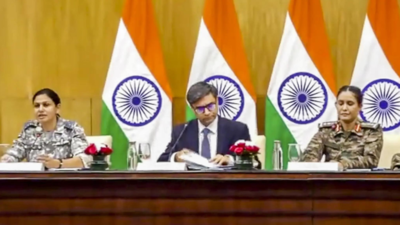NEW DELHI: The ministry of external affairs on Friday briefed the country about rapidly escalating tensions between India and Pakistan, revealing details about Pakistan’s recent cross-border provocations. The MEA said that the Pakistani military launched around 300 to 400 drones, identified as Turkish-made Asisguard Songar models-towards Indian positions while also using civilian airliners as a shield to deter Indian counterattacks.However, the majority of Pakistan-launched drones were intercepted and destroyed by Indian air defence system.Despite initiating drone and missile strikes late Thursday night, Pakistan kept its civil airspace open, allowing commercial aircraft to operate dangerously close to the International Border. This, MEA officials said, was a deliberate attempt to complicate India’s defensive response and endanger innocent passengers.Colonel Sofiya Qureshi detailed the scale and intent of the attack: “On the night of May 7 and 8, the Pakistani army violated Indian airspace several times over the entire western border with the intention of targeting military infrastructure. Not only this, the Pakistani army also fired heavy caliber weapons along the Line of Control. Around 300 to 400 drones were used to attempt infiltration at 36 locations. The Indian armed forces shot down many of these drones using kinetic and non-kinetic means. The possible purpose of such large-scale aerial intrusions was to test air defence systems and collect intelligence. Forensic investigation of the wreckage of the drones is being done. Initial reports suggest that they are Turkish Asisguard Songar drones…”The Indian Air Force (IAF), in a high-alert state, ensured the safety of airspace on its side by suspending all civilian air traffic. However, Pakistani commercial flights were still airborne near the conflict zone.Wing Commander Vyomika Singh highlighted the grave risk posed by this tactic: “Pakistan is using civil airliner as a shield, knowing fully well that its attack on India would elicit a swift air defence response. This is not safe for the unsuspecting civil airliners including the international flights which were flying near IB between India and Pakistan. The screenshot we just showed, it shows the data of the application flight radar 24 during a high air defence alert situation in the Punjab sector. As you have seen, the airspace on the Indian side is absolutely devoid of civil air traffic due to our declared closure. However, there are civil airlines flying the air route between Karachi and Lahore… Indian Air Force demonstrated considerable restraint in its response thus ensuring safety of international civil carriers.”Foreign secretary Vikram Misri condemned Pakistan’s actions as both provocative and irresponsible: “These provocative and escalatory actions taken by Pakistan last night were targeted at Indian cities and civilian infrastructure in addition to military establishments. Indian armed forces responded proportionately, adequately, and responsibly… The official and blatantly farsical denial of these attacks that Pakistan carried out, by the Pakistani state machinery is another example of their duplicity and the new depths, they are plumbing to…”Wing Commander Singh confirmed: “In response to the Pakistani attack, armed drones were launched at four air defence sites in Pakistan. One of the drones was able to destroy an AD radar. Pakistan also carried out artillery shelling across the line of control using heavy-calibre artillery guns and armed drones… which resulted in some losses and injuries to Indian army personnel. Pakistan army also suffered major losses in Indian retaliatory fire.”On May 7, India launched its major counterterror action under Operation Sindoor, that targeted 9 terror launchpads in Pakistan and PoK. This action came in strong retaliation to Pakistan-sponsored terror attack in Jammu and Kashmir’s Pahalgam that claimed 26 lives on April 22.







